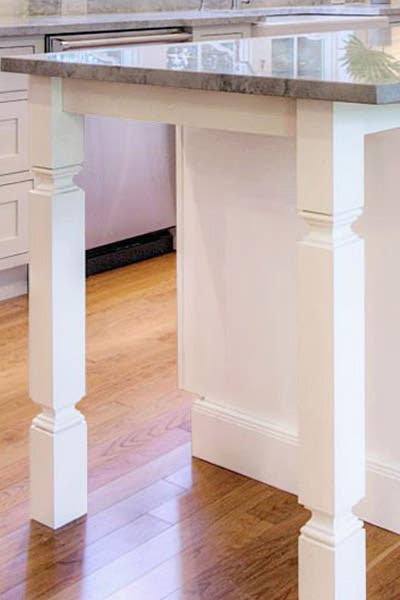A Guide to Picking the Perfect Legs For Kitchen Island for Your Home
Picking the ideal legs for your kitchen area island is a nuanced decision that impacts both the capability and aesthetic appeal of this central space. As you consider these elements, it becomes apparent that the best legs can transform not just the look of your cooking area but also its use for years to come.

Comprehending Cooking Area Island Legs
When selecting legs for a kitchen area island, it's necessary to recognize their aesthetic and useful roles in the general layout. The legs act as an important support group, guaranteeing security and longevity for the island, which often works as a work space, dining area, or gathering spot. Therefore, the option of material and building and construction strategy must be robust sufficient to stand up to everyday use and potential wear.
In addition to their architectural duties, legs contribute dramatically to the island's aesthetic appeal. They can boost the cooking area's style, whether through standard, contemporary, or eclectic designs. The elevation and percentage of the legs are likewise essential considerations; they have to integrate with the island's kitchen counter elevation while ensuring comfortable seating for those making use of the area.
In addition, the leg layout can affect the overall flow of the kitchen. Open, ventilated leg designs can produce a sense of agility, while strong, substantial legs may convey an extra grounded and steady visual - Legs For Kitchen Island. Recognizing these visual and functional elements will certainly direct property owners in making educated options that match their cooking area's design and boost its usability
Popular Styles and Materials
The selection of legs for a kitchen island encompasses a variety of popular designs and materials, each offering unique attributes that can improve both performance and visual appeals. Conventional legs normally exhibit ornate information and workmanship, boosting traditional cooking area designs.

Elevation and Stability Considerations

Stability is an additional crucial consideration. The legs of the kitchen area island should supply ample assistance, making certain that the structure can stand up to everyday usage without changing or tottering. Product selection plays a substantial duty in stability; steel legs, for example, often visit this page tend to provide higher stamina compared to timber. Additionally, guaranteeing that the island is safely anchored to the floor or wall can enhance security, specifically for bigger islands that might birth significant weight.
Matching Your Cooking Area Aesthetic
Selecting the best legs for your kitchen island goes past functionality; it also plays a considerable duty in the overall visual of the space. When selecting legs, think about the layout style of your kitchen. For a contemporary appearance, smooth steel or minimal styles can produce a clean, modern-day vibe. On the other hand, rustic or typical kitchen areas often gain from wood legs with elaborate detailing or a troubled surface, enhancing heat and character.
Legs that enhance or comparison with your island's surface and surrounding cabinetry can produce aesthetic consistency or striking focal points. Additionally, consider the finish of the legs; matte, shiny, or distinctive surfaces can dramatically impact the total feeling of the cooking area.
Installation and Maintenance Tips
Mounting cooking area island legs requires cautious focus to detail to guarantee both security and aesthetic charm. Begin by picking a suitable location for your island, ensuring it is level and has adequate area for movement. If you are connecting the legs to a wall or using brackets for added support, utilize a stud finder to useful link situate wall surface see this here studs. Mark the positioning of the legs properly before exploration.
When securing the legs, use top quality screws and, if required, timber glue for added strength. For metal legs, make certain that you are utilizing proper supports and tools to avoid damages to your floor covering. It is suggested to inspect for levelness after installation, making changes as needed to avoid wobbling.
Upkeep is equally important for long life - Legs For Kitchen Island. Frequently check the legs for any type of indicators of wear or helping to loosen, especially in high-traffic areas. Tidy the legs with an appropriate cleaner, staying clear of abrasive materials that might damage the surface area. For wooden legs, take into consideration using a wood conditioner regularly to maintain their surface. By following these installation and maintenance tips, you can ensure that your cooking area island legs stay both aesthetically enticing and functional.
Verdict
In verdict, selecting the ideal legs for a cooking area island necessitates careful consideration of height, stability, and aesthetic compatibility. Inevitably, thoughtful leg selection plays a crucial role in raising both the functionality and design of the kitchen room.
When choosing legs for a cooking area island, it's crucial to comprehend their functional and aesthetic duties in the overall layout. Open, airy leg designs can create a feeling of agility, while strong, significant legs may convey an extra grounded and steady aesthetic. The legs of the kitchen island need to supply sufficient assistance, ensuring that the framework can endure daily usage without tottering or changing.Mounting kitchen island legs calls for cautious focus to information to make certain both security and visual allure.In final thought, picking the suitable legs for a kitchen island necessitates cautious factor to consider of elevation, stability, and aesthetic compatibility.